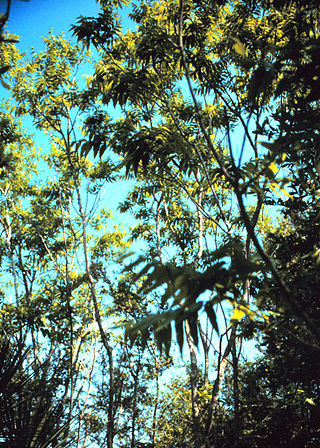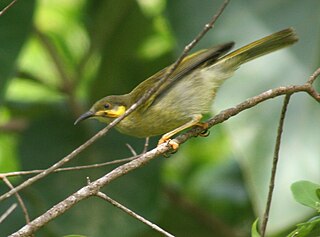
Lycopodium is a genus of clubmosses, also known as ground pines or creeping cedars, in the family Lycopodiaceae. Two very different circumscriptions of the genus are in use. In the Pteridophyte Phylogeny Group classification of 2016, Lycopodium is one of nine genera in the subfamily Lycopodioideae, and has from nine to 15 species. In other classifications, the genus is equivalent to the whole of the subfamily, since it includes all of the other genera. More than 40 species are accepted.

Sapindus is a genus of about five to twelve species of shrubs and small trees in the lychee family, Sapindaceae, native to warm temperate to tropical regions of the world. The genus includes both deciduous and evergreen species. Members of the genus are commonly known as soapberries or soapnuts because the fruit pulp is used to make soap. The generic name is derived from the Latin words sapo, meaning "soap", and indicus, meaning "of India".
In professional wrestling, the Samoan SWAT Team was a tag team who competed in promotions including World Wrestling Council, World Class Championship Wrestling, and World Championship Wrestling (WCW) in the late 1980s and early 1990s. The team later appeared in the World Wrestling Federation as the Headshrinkers and in Extreme Championship Wrestling as the Samoan Gangster Party. The team originally comprised Fatu and Samu, but various iterations included Big Matty Smalls, Samoan Savage, and Sione. Most members of the team were members of the Anoa'i family and were managed by Paul Heyman at one point who currently manages Fatu's sons and Matty's brother, The Usos, Solo Sikoa and Roman Reigns respectively, collectively known as The Bloodline. The current members are Juicy Finau, Lance Anoa'i and Jacob Fatu, who work in Major League Wrestling (MLW), with Finau and Lance the current MLW World Tag Team Champions.

Asteliaceae is a family of flowering plants, placed in the order Asparagales of the monocots.

The Mymaridae, commonly known as fairyflies or fairy wasps, are a family of chalcidoid wasps found in temperate and tropical regions throughout the world. The family contains around 100 genera with 1,400 species.

Ochyroceratidae is a six-eyed spider family, with 165 described species in ten genera. They are common inhabitants of caves and the tropical forest litter of South Africa, the Caribbean, Asia and South America. Considered an ecological counterpart of the Linyphiidae of the northern temperate zone, species are especially diverse in the Indo-Pacific region.

The Polynesian wattled honeyeater or the eastern wattled honeyeater, is a species of bird in the honeyeater family Meliphagidae. It was considered conspecific with the Fiji wattled honeyeater and the kikau.

The Samoan flycatcher is a species of bird in the family Monarchidae. It is endemic to Samoa. Its natural habitats are subtropical or tropical moist lowland forests, subtropical or tropical moist montane forests, and rural gardens and is threatened by habitat loss.

The cardinal myzomela is a species of bird in the honeyeater family Meliphagidae. It is named for the scarlet color of the male. It is found in American Samoa, New Caledonia, Samoa, Solomon Islands, and Vanuatu, as well as some islands in Micronesia such as Yap. Its natural habitats are subtropical or tropical moist lowland forest and subtropical or tropical mangrove forest. It frequents areas with flowers, such as gardens. This is a small, active bird, measuring about 13 cm (5.1 in) from bill to tail. Males are red and black in coloration, females are grayish-olive, sometimes with a red cap or red head. Its long, curved bill is especially adapted for reaching into flowers for nectar. Cardinal myzomela populations have vanished from the island of Guam since the invasion of the brown tree snake.

Balaka is a genus of 9 known species in the palm family, Arecaceae or Palmae. Seven species are native to the islands of Fiji and two to Samoa. The genus was first proposed and published in Annales du Jardin Botanique de Buitenzorg 2: 91. 1885, from two species originally in the genus Ptychosperma.

The National University of Samoa is the only national university in Samoa. Established in 1984 by an act of parliament, it is coeducational and provides certificate, diploma, and undergraduate degree programs, as well as technical and vocational training. About 2,000 students were enrolled in 2010 with an estimated 300 staff. It offers a wide range of programmes including Arts, Business and Entrepreneurship, Education, Science, Nursing, Engineering and Maritime Training. The Centre for Samoan Studies, established in the university for the teaching of the Samoan language and culture, offers undergraduate and graduate degrees as well as the world's first degree in Master of Samoan Studies.
Balaka insularis is a rare species of flowering plant in the palm family endemic to Samoa. It was formerly placed in the monotypic genus Solfia with the species name Solfia samoensis. It was placed in the genus Balaka in 2014.

American Samoa is an unincorporated territory of the United States located in the South Pacific Ocean, southeast of the island country of Samoa. Centered on 14.3°S 170.7°W, it is east of the International Date Line and the Wallis and Futuna Islands, west of the Cook Islands, north of Tonga, and some 500 kilometers (310 mi) south of Tokelau. American Samoa is the southernmost territory of the United States and one of two U.S. territories south of the Equator, along with the uninhabited Jarvis Island.

Chlaenius is a large and diverse genus of ground beetle. It is native to the Palearctic realm, Afrotropical realm, and Nearctic realm. Worldwide, roughly 1,000 species are currently recognized with the majority of known species occurring in the Oriental and Afrotropical regions. The genus is divided into many subgenera.
Assara albicostalis is a moth of the family Pyralidae. It has a wide distribution and has been recorded from India, Sri Lanka, Thailand, Sabah, the Philippines, Taiwan, Sulawesi, Australia, Fiji, Tahiti, Samoa, Hawaii and the Marquesas. This is the type species of genus Assara.
Neanops is a genus of beetles in the family Carabidae, containing the following species:
Nelsonites is a genus of beetles in the family Carabidae, containing the following species:

Lalage is a genus of passerine birds belonging to the cuckooshrike family Campephagidae, many of which are commonly known as trillers. There are about 18 species which occur in southern Asia and Australasia with a number of species on Pacific islands. They feed mainly on insects and fruit. They build a neat cup-shaped nest high in a tree.

Bryocyclops is a genus of freshwater-dwelling cyclopoid copepods. The epithet Bryo- for Bryophyta (Mosses) refers to the fact that the first few species were described from mosses.













